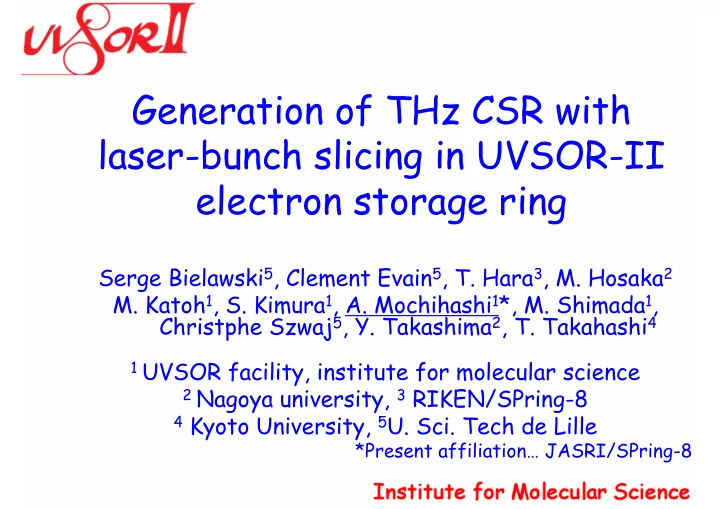

Generation of THz CSR with laser-bunch slicing in UVSOR-II electron storage ring Serge Bielawski 5 , Clement Evain 5 , T. Hara 3 , M. Hosaka 2 M. Katoh 1 , S. Kimura 1 , A. Mochihashi 1 *, M. Shimada 1 , Christphe Szwaj 5 , Y. Takashima 2 , T. Takahashi 4 1 UVSOR facility, institute for molecular science 2 Nagoya university, 3 RIKEN/SPring-8 4 Kyoto University, 5 U. Sci. Tech de Lille *Present affiliation… JASRI/SPring-8
Contents • Bunch-slicing experiment in UVSOR-II – Setup – Experimental results • Bunch slicing with amplitude-modulated laser – Principle – Experimental results • Summary
UVSOR-II Electron Storage Ring Electron Energy 600 MeV Circumference 53.2 m Natural Emittance 17.4 nm-rad Natural Energy Spread 3.4 x 10 -4 Natural Bunch Length 3.1 cm (~100psec) RF Frequency 90.1 MHz Revolution Frequency 5.6 MHz Synchrotron Frequency 14.4 kHz Damping time 19 msec Undulator Length 2.31 m The laser system is settled outside the ring now!
Setup for Laser-bunch slicing in UVSOR-II (3) THz CSR corresponds to the dip structure can be generated. (1) Electrons in the ring interact with the laser in the undulator section and are partially energy- modulated. (2) The energy-modulated electrons go away from their central orbit and make a dip on the electron bunch.
Generation of a Dip on a Bunch Short laser pulse Examples of dips by duration short/long laser pulses Passing through a section with 2 bending magnets… 2 ∫ Form Factor ( ) ( ) ikz F k = ρ z e dz ( ) ∆ E z 0 laser z → z + R 0 1 56 E Form factor from shorter pulse has higher frequency components. CSR spectrum Long laser pulse can change duration
Ti:Sa Laser and Timing System Pulse Energy 2.5mJ/pulse Pulse Width 130fs ~ 2ps Repetiton Rate 1 kHz (synchronized with RF signal of 90.1MHz) Wavelength 790 ~ 810nm Peak power ~18GW @130fs Momentum acceptance ~ 0.01 Natural energy spread ~ 3.4E-4
Detection System at BL6B, UVSOR-II Detector Type Hot electron (InSb) Time Resolution 1.6 µ sec Spectral Range 3 ~ 50cm -1 5 × 10 5 V/W Sensitivity (including beam-line optics) Temperture 4K (cooled by Liq. He) Bending #6 Magic mirror Martine-Puplett To BL6U Diamond interferometer JASCO THz microscope / z-cut FARIS-1 Quartz Resolution<0.5cm -1 window Bruker IFS66v/S Refection- absorption spectroscopy 0 500 1000 station
Experimantal Results (Temporal structure) Temporal relation between the laser trigger and THz signal observed at BL6B. The intensity of the THz pulse is 10 4 - 10 5 larger than that of the normal THz radiation. •Pulse width of the single pulse ~ 1.6 µ s … that almost corresponds to the response time of the detector. •Revolution period of the beam = 0.18 µ s … detectors that have faster response time are needed !
Experimental Results (I b dependence, Spectrum) Cut-off from optics Absorption by water •Squared-dependence of the intensity on the peak current … CSR •The CSR spectra depend on the pulse duration of the laser … longer laser pulse duration makes longer dip, so that longer wavelength components become coherent radiation.
CSR generation with AM laser pulse Power spectrum of CSR: ( ) [ 1 ( 1 ) ( )] ( ) P k = N + N − F k p k 2 ∫ ikz ( ) ( ) F k z e dz = ρ : Longitudinal electronic distribution ( ) ρ z •Wide spectrum Single pulse … •Small spectral peak 1 •Narrow spectrum ∝ M Modulated pulse … ( with M-peaks) •Large spectral peak 2 ∝ M THz CSR spectrum Electronic distribution (excluding whole bunch component)
'Chirped pulse beating' Weling, A.S & Auston, D.H, J. Opt. Soc. Am. B 13, 2783-2791 (1996) •CCR, RRF : retroreflector •BS : beam splitter •G1, G2 : gratings 1. Making chirp on the laser pulse with a pair of gratings 2 ( ) exp( ) E t ∝ − i ω t − at 2. Leading the chirped pulses to the Michelson interfelometer, and adjusting optical delay. Generation of the beat structure that corresponds to the frequency difference between two chirped pulses 2 | ( / 2 ) ( / 2 ) | I = E t + τ + E t − τ cos[ 2 Im( ) ] = C + C a t τ + ωτ 1 2
Modulated laser pulse and related CSR spectrum Measurement of the modulated laser pulse with auto correlator •Narrower spectral width with the modulated laser pulse •The spectral peak frequency is tunable by changing the beat structure of the laser. Band width ~ 4cm-1 @ pulse duration = 1 ~ 2 ps
Output from auto-correlator CSR spectrum Band width ~ 1cm-1 Laser pulse duration 60ps (much beating) Band width ~ 4cm-1 Laser pulse duration 1~2 ps (less beating)
Changing CSR frequency We changed the beating frequency and estimated the laser modulation frequency from the auto-correlator measurement Clear correlation between the laser frequency and the CSR peak spectrum
Summary • We have observed intense THz synchrotron radiation by laser-bunch slicing method in UVSOR-II. – squared dependence of the peak intensity on the peak current … CSR – band width depends on the pulse duration of the laser • THz CSR generation with AM laser pulse – narrow band THz CSR – peak frequency depends on the AM (tunable)
Recommend
More recommend